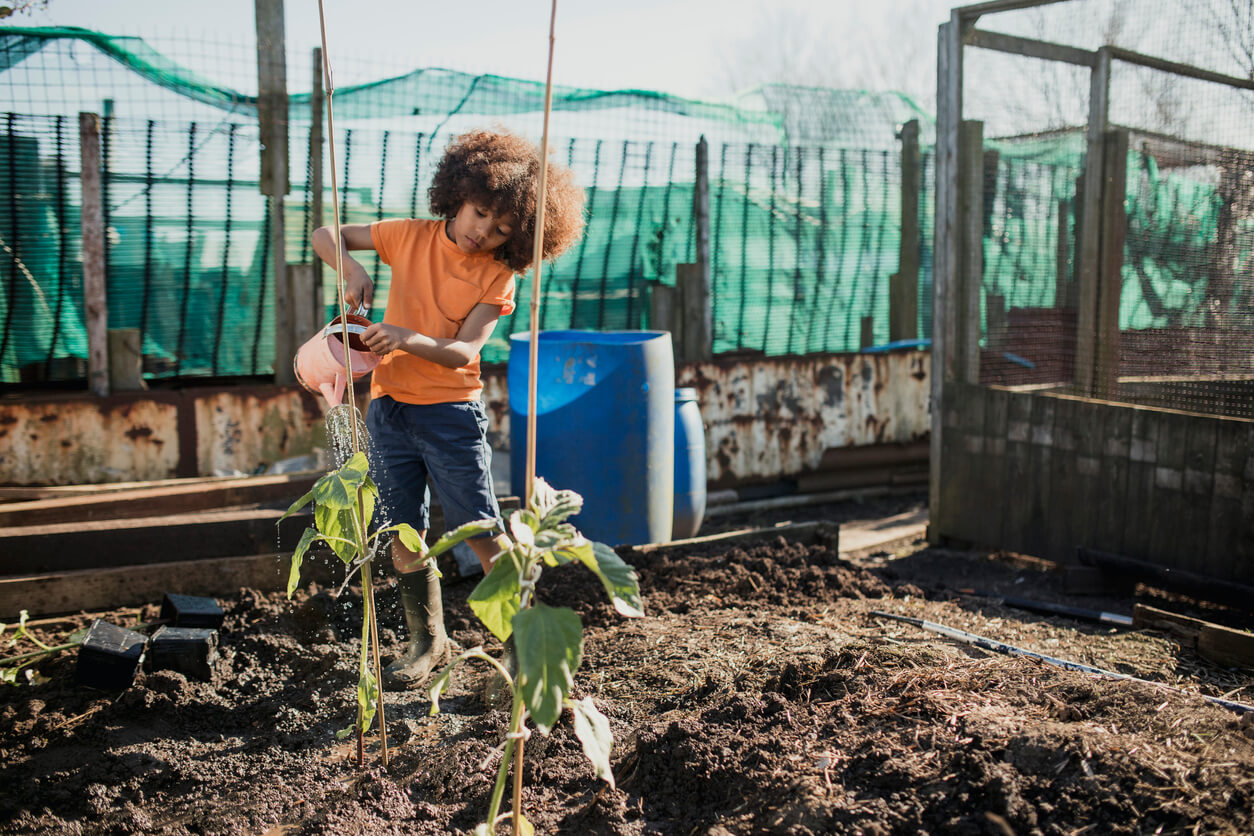
Child taking care of his growing sunflower plants
Growing sunflower plants means having the right tools to do the job. And you need the right tools in the kitchen, too, for being able to prepare sunflowers for your eating enjoyment!
Below is a list of items to consider. If you don’t already have some of these items, please check our Resources section at the end of this gardening guide for recommended suppliers for acquiring the right tools and equipment.
Sunflower-specific tools and equipment
Sunflower seed roller: If you plan to plant a lot of sunflowers, a seed roller can be a great back-saver. Of course, the seed roller is an attachment; you’ll need a push seeder to go with it. Available at Johnny’s Selected Seeds and other garden suppliers.
Sunflower seed peeler: If the rolling pin of shelling sunflowers doesn’t appeal to you, or you or someone in your family needs a low-key activity, get a seed peeler/cracker. Feed a seed into the top of this gizmo and the motor will turn the wheel, pull the sunflower seed through, and separate it from its shell. You can also get a battery-free model—perfect for having young ones help out with the harvest. Available at Amazon, Walmart, and kitchen supply stores.
Sunflower seed pliers: This tool looks like a little pair of pliers, or kind of like a big nail clipper. Feed in a seed, squeeze the handle, and out will pop your freshly peeled seed! Available at Amazon, Walmart, and kitchen supply stores.
Sunflower seed shucker scissors: Resembling a pair of manicure scissors, this tiny little nutcracker tool has openings of various widths to accommodate the small seeds of your choice. A relaxing way to remove your sunflower seed shells. Available at Amazon, Walmart, and kitchen supply stores.
General gardening tools and equipment:
Containers and Pots
If you want to start plants indoors before the outdoor growing season commences, you can try several environmentally friendly and free ways to begin with materials you probably already have:
- Newspaper or brown-paper pots
- Egg cartons
- Toilet-paper rolls (yes, these work great!)
- Random containers, kitchen pans, or baking sheets (you might need holes drilled into the bottom for drainage)—if you have aging or rusting kitchen pans that you’re looking to replace, they make for great “starter pots” for getting your garden launched inside
- Starter trays and peat pots
Garden Gloves
Using a pair of garden gloves—and wearing long sleeves—when you’re tending to your plants is a good way to avoid skin irritation and to protect your fingers, hands, and arms. Get a comfortable pair of gloves that fit well, so you still have full dexterity in your garden.
Garden Trowel
A useful garden tool, the garden trowel is handy when filling your containers and when mixing compost and worm castings. Avoid cheap versions that can have flimsy handles that are prone to break. Even inferior metal trowels can bend in hard clay or rocky soil. Invest in a higher quality trowel, and you’ll have it for years!
Irrigation Equipment
Many plants thrive when watered slowly and deeply. While tedious and even sometimes difficult to do with a watering can, you might want to consider an irrigation method for keeping your plants slowly and deeply watered.
A standard sprinkler system is not the best solution—while easy to set up, the wide-ranging water coverage of a sprinkler can lead to wet plant leaves that promote diseases and can encourage weeds.
A drip-watering irrigation system that operates on a timer is one of the best irrigation solutions for watering plants. This type of system better controls how much water you use, minimizes water lost to evaporation, and more exactly directs water to where you want to soak your soil. While more expensive than a simple watering can, an investment in an irrigation system can pay off—specially to ensure proper watering when you’re at work or on vacation!
Pruners or Snippers
Wear your garden gloves while pruning, and be sure to get a set of pruners or snippers that are comfortable in your hand when cutting. Don’t skimp on this—you need something that cuts well and will endure through many seasons.
Rain Barrel
Some areas of the country experience drought conditions in the spring and summer, and some municipalities may impose watering bans; that means hand watering only. If you collect rainwater, you can put it to good use when it comes time to tend your plants. Some communities offer rain barrels at a special discount to encourage water conservation.
Spade
Every gardener—no matter what plants you’re tending—needs a spade, or even several of different sizes. Use your spade to move around compost, dig soil for your initial plant hole, and to keep your garden soil tidy.
Spray Pump or Bottle
To control the emergence or spread of plant diseases and pests, get a dedicated spray bottle for your potion to do the job. This is one thing you can go basic on—no need for anything fancy, as a simple plastic spray bottle is fine.
Watering Can
Watering cans allow you to better control exactly where the water is directed in your garden. Plant leaves and fruit don’t need water, the roots in the soil do. Get yourself a good-sized watering can, and have some fun finding a watering can with an interesting design that fits your personality. Also, you want one that has a comfortable grip.
Wheelbarrow
A wheelbarrow makes it easy for you to move soil and mulch from plant to plant; and it works as an excellent mixing bowl when you’re combining the perfect soil blend. If you feel like a wheelbarrow is just a little over the top for your gardening needs, a 5-gallon bucket may suffice. Just make sure you have a good trowel to mix with.
Do you have any essential gardening tools you use that aren’t listed here? Please tell us which items you absolutely need for your gardening.


 Previous
Previous

